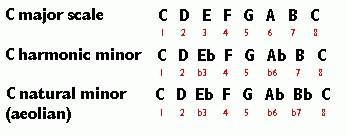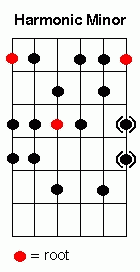The Harmonic Minor Scale
by Gremeg (Apr 22, 2008)
Lesson: The Harmonic Minor Scale
Good guitarists have a vast repetoire of harmonic material to draw from. Even in the pop, rock, and blues genres, where pentatonic and blues scales make up the bulk of scales used in improvising, there are times when those scales don't provide the correct color for particular situations. Nor does a 'typical' minor scale, like the natural minor (also known as aeolian). These are times when a guitarist might look to a more exotic sounding scale, like the harmonic minor.
THE NOTES:

The above example illustrates a C harmonic minor scale, constrasted against both the major and natural minor scales. Notice the harmonic minor scale differs from the natural minor scale in just one note; the raised seventh. This note contains the strongest color in the scale, in that it carries a certain degree of tension, and should be used with this knowledge in mind. Hanging onto the seventh degree of the scale, then resolving it up a semi-tone to the root is a nice way to create a tension-release scenario when improvising. The flattened third and sixth note of the harmonic minor scale would generally prevent it from being used against major chords with the same root note in an improvising situation (for example, a C harmonic minor scale would not normally be used against a C major chord).
THE SCALE:

When playing the scale, make sure to do all stretching with the pinky (4th) finger in your left hand. Notes normally played with the pinky should still be played with the pinky (do not stretch with your 3rd finger on the first and sixth strings to play the notes your pinky would normally play - there's no logical reason to do this.) Care should be taken to play the scale accurately and slowly, using alternate picking, until it can be played with reasonable precision. Only then should the scale be attempted at a slightly faster tempo. Using a metronome is, as always, the beneficial way of practising scales such as this.
Root notes of the scale are marked in red, and the last two notes are bracketed to illustrate that the scale is, at this point, extending beyond two octaves.
This illustration is just a jumping-off point for learning the harmonic minor scale. Once comfortable with the sound of the scale, guitarists should teach themselves to play the scale all over the fretboard in different positions, up one string, etc. either by using their ear to figure out the correct notes, or by following the scale steps illustrated above and below.
DIATONIC CHORDS OF:

Like the major scale, we can derive a series of chords out of each of the seven notes in the harmonic minor scale, by stacking each note with notes from the scale a diatonic third and fifth above it. Although the end process may not yield a set of chords as user-friendly as those derived from the major scale, they are nonetheless important to know and understand. Using the above illustration, for example, we can see if a progression moves from Vmaj to Imin, the harmonic minor scale would be an appropriate choice.
The harmonic minor scale can also be "forced" over a static chord progression that does not initially seem receptive to the harmonic minor sound. For example, a tune in the key of A minor, that vamps on Amin for a long time, can often be a good situation to use the harmonic minor scale. It will often create a sound that could be considered exotic, or unusual, so be prepared for this.
The harmonic minor is just one of many scales that can be used to provide different color to minor chords (others include melodic minor, phrygian, dorian, etc.) For every minute spent practising the scale itself, guitarists should spend another minute listening to each note of the scale against a repeatedly strummed minor chord (record a rhythm track of yourself playing), paying attention to the specific color each note gives, and where it wants to resolve to. Also, listen for the use of the harmonic minor scale by your favorite guitarist. Be able to sing the scale without having to think about it. Practise moving from a minor pentatonic into a harmonic minor scale, and back again. Learning a scale goes far beyond memorizing the shape on the neck of the guitar; it involves internalizing the sound of the scale itself.
Good guitarists have a vast repetoire of harmonic material to draw from. Even in the pop, rock, and blues genres, where pentatonic and blues scales make up the bulk of scales used in improvising, there are times when those scales don't provide the correct color for particular situations. Nor does a 'typical' minor scale, like the natural minor (also known as aeolian). These are times when a guitarist might look to a more exotic sounding scale, like the harmonic minor.
THE NOTES:

The above example illustrates a C harmonic minor scale, constrasted against both the major and natural minor scales. Notice the harmonic minor scale differs from the natural minor scale in just one note; the raised seventh. This note contains the strongest color in the scale, in that it carries a certain degree of tension, and should be used with this knowledge in mind. Hanging onto the seventh degree of the scale, then resolving it up a semi-tone to the root is a nice way to create a tension-release scenario when improvising. The flattened third and sixth note of the harmonic minor scale would generally prevent it from being used against major chords with the same root note in an improvising situation (for example, a C harmonic minor scale would not normally be used against a C major chord).
THE SCALE:

When playing the scale, make sure to do all stretching with the pinky (4th) finger in your left hand. Notes normally played with the pinky should still be played with the pinky (do not stretch with your 3rd finger on the first and sixth strings to play the notes your pinky would normally play - there's no logical reason to do this.) Care should be taken to play the scale accurately and slowly, using alternate picking, until it can be played with reasonable precision. Only then should the scale be attempted at a slightly faster tempo. Using a metronome is, as always, the beneficial way of practising scales such as this.
Root notes of the scale are marked in red, and the last two notes are bracketed to illustrate that the scale is, at this point, extending beyond two octaves.
This illustration is just a jumping-off point for learning the harmonic minor scale. Once comfortable with the sound of the scale, guitarists should teach themselves to play the scale all over the fretboard in different positions, up one string, etc. either by using their ear to figure out the correct notes, or by following the scale steps illustrated above and below.
DIATONIC CHORDS OF:

Like the major scale, we can derive a series of chords out of each of the seven notes in the harmonic minor scale, by stacking each note with notes from the scale a diatonic third and fifth above it. Although the end process may not yield a set of chords as user-friendly as those derived from the major scale, they are nonetheless important to know and understand. Using the above illustration, for example, we can see if a progression moves from Vmaj to Imin, the harmonic minor scale would be an appropriate choice.
The harmonic minor scale can also be "forced" over a static chord progression that does not initially seem receptive to the harmonic minor sound. For example, a tune in the key of A minor, that vamps on Amin for a long time, can often be a good situation to use the harmonic minor scale. It will often create a sound that could be considered exotic, or unusual, so be prepared for this.
The harmonic minor is just one of many scales that can be used to provide different color to minor chords (others include melodic minor, phrygian, dorian, etc.) For every minute spent practising the scale itself, guitarists should spend another minute listening to each note of the scale against a repeatedly strummed minor chord (record a rhythm track of yourself playing), paying attention to the specific color each note gives, and where it wants to resolve to. Also, listen for the use of the harmonic minor scale by your favorite guitarist. Be able to sing the scale without having to think about it. Practise moving from a minor pentatonic into a harmonic minor scale, and back again. Learning a scale goes far beyond memorizing the shape on the neck of the guitar; it involves internalizing the sound of the scale itself.